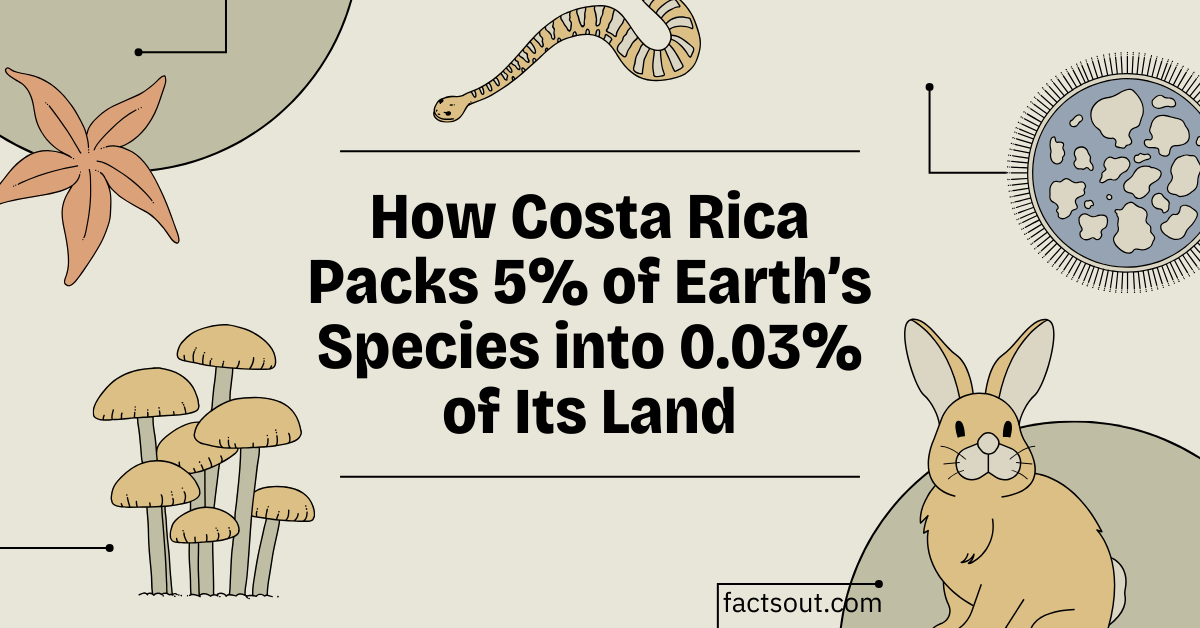Imagine a place smaller than West Virginia, yet teeming with more species than the entire United States and Europe combined. A place where scarlet macaws soar above volcanoes, jaguars slink through the rainforest, and three-toed sloths nap in misty canopies.
Welcome to Costa Rica — a country that covers just 0.03% of the Earth’s surface, but hosts over 5% of its known biodiversity. It’s not just a fluke of geography — it’s a masterclass in ecological design.
But how did this tiny tropical nation become one of the world’s most extraordinary biodiversity hotspots?
The answer lies in a brilliant mix of biological corridors, varied microclimates, tectonic luck, and one visionary conservation movement.
🌎 The Numbers That Blow Minds
Let’s start with a snapshot of why Costa Rica is so special:
| Category | Global % in Costa Rica |
|---|---|
| Earth’s surface area | 0.03% |
| Bird species | ~9% (over 900 species!) |
| Butterfly species | ~10% of global total |
| Mammals | 250+ species |
| Reptiles/Amphibians | 400+ species |
| Plant species | Over 12,000 |
📌 That’s 1 in every 20 species on the planet, packed into a sliver of land between Nicaragua and Panama.
🧬 What Makes Costa Rica So Wild?
Costa Rica isn’t just lucky — its natural features and national policies create the perfect storm for biodiversity.
1. 🌡️ A Tapestry of Microclimates
You can drive from tropical dry forest to cloud forest to mangrove swamp in a few hours.
Thanks to:
- Mountain ranges (Cordillera de Talamanca & Cordillera Central)
- Active volcanoes
- Altitudes from sea level to 3,800m
- Two coastlines: Pacific & Caribbean
👉 This creates over 30 distinct microclimates, allowing diverse life forms to coexist in close quarters.
Example: In Monteverde Cloud Forest, temperatures and moisture levels vary dramatically even within a few kilometers, allowing orchids, mosses, birds, and amphibians to occupy ultra-specific niches.
2. 🌱 Biological Corridors: Nature’s Highways
While much of the world fragments ecosystems with roads and cities, Costa Rica connects them through a vast network of biological corridors.
What are they?
Think of biological corridors as nature’s expressways — stretches of protected or semi-protected land that link wildlife habitats so animals and plants can migrate, reproduce, and adapt.
Why do they matter?
- They prevent inbreeding in isolated animal populations
- Allow species to move in response to climate change
- Help maintain genetic diversity and healthy ecosystems
🔄 Costa Rica is part of the Mesoamerican Biological Corridor, a regional initiative that stretches from southern Mexico to Panama.
3. 🌋 A Geologist’s Playground
Costa Rica sits at the collision zone of five tectonic plates. This geological dance created:
- Volcanoes (like Arenal, Poás, Irazú)
- Diverse soils rich in nutrients
- Unique terrain, ideal for plant diversity
So not only is it hot and wet in the right places, but the soil is bursting with life-giving minerals — the perfect foundation for rich ecosystems.
4. 🌳 The Reforestation Revolution
Costa Rica’s biodiversity wasn’t always secure.
🪓 In the 1970s-80s, deforestation peaked, with nearly 60% of forests lost to cattle ranching and monoculture farming.
But then came the green miracle.
Key conservation milestones:
- 🌿 1996: Launch of the Payment for Environmental Services (PES) program. Landowners get paid to preserve forests and plant trees.
- 🌱 2000s onwards: Massive investment in eco-tourism, creating economic incentives for conservation.
- 📈 Today: Over 52% of Costa Rica is covered in forest, up from 21% in the 1980s.
That’s one of the fastest national reforestation successes in the world.
🐒 Wildlife You Won’t Believe
Here’s a peek at Costa Rica’s living treasure chest:
| Animal | Fact |
|---|---|
| Resplendent Quetzal | Can only survive in high-altitude cloud forests |
| Glass Frog | Its translucent belly shows its internal organs |
| Blue Morpho Butterfly | One of the largest butterflies in the world |
| Mantled Howler Monkey | Loudest land animal in the Americas 🐒 |
| Jaguar | Top predator; a sign of ecosystem health |
| Sloths | So slow that algae grows on their fur 🦥 |
👣 Eco-Tourism Meets Eco-Consciousness
Costa Rica’s biodiversity isn’t just for scientists — it’s a major part of its economy.
Tourism Snapshot:
- 🧳 Over 3 million tourists annually
- 💰 Eco-tourism contributes 6% of GDP
- 🌐 Most visited country in Central America
From zip-lining through the rainforest to watching sea turtles nest on Caribbean beaches, biodiversity is the backbone of the experience.
📚 Education + Enforcement = Conservation Culture
Costa Ricans grow up surrounded by nature — and education emphasizes its value from an early age.
- National parks are common school trip destinations
- Environmental science is a core subject
- Laws are enforced — harming endangered species or cutting protected trees can bring severe fines or jail time
This culture has bred a generation of citizen conservationists.
🌎 A Model for the World?
While many nations talk about sustainability, Costa Rica is walking the walk — and setting examples globally.
Highlights:
- 🌿 First country to reverse deforestation
- ⚡ 98% of energy from renewables
- 🌍 Hosting international climate talks & research
- 🐾 Home to conservation orgs like Osa Conservation, Monteverde Institute, and INBio
🔚 Final Thought: Nature’s Goldmine, Protected by Purpose
In a time of climate anxiety and mass extinction, Costa Rica shines like a beacon — proving that sustainability, biodiversity, and prosperity can coexist.
This tiny nation has achieved what many thought impossible: turning its natural wealth into a national identity and economic engine, all while protecting the planet.
It’s not just a paradise for wildlife — it’s a blueprint for survival.
So next time you hear “Costa Rica,” don’t just think volcanoes and toucans — think biodiversity brilliance, powered by vision.



